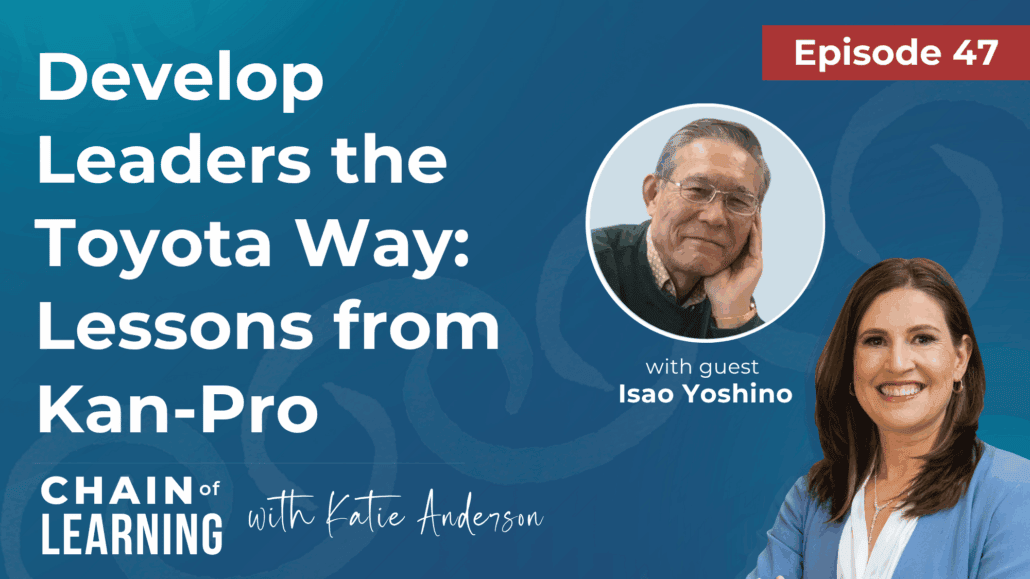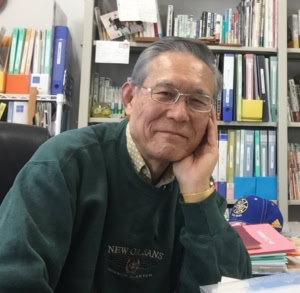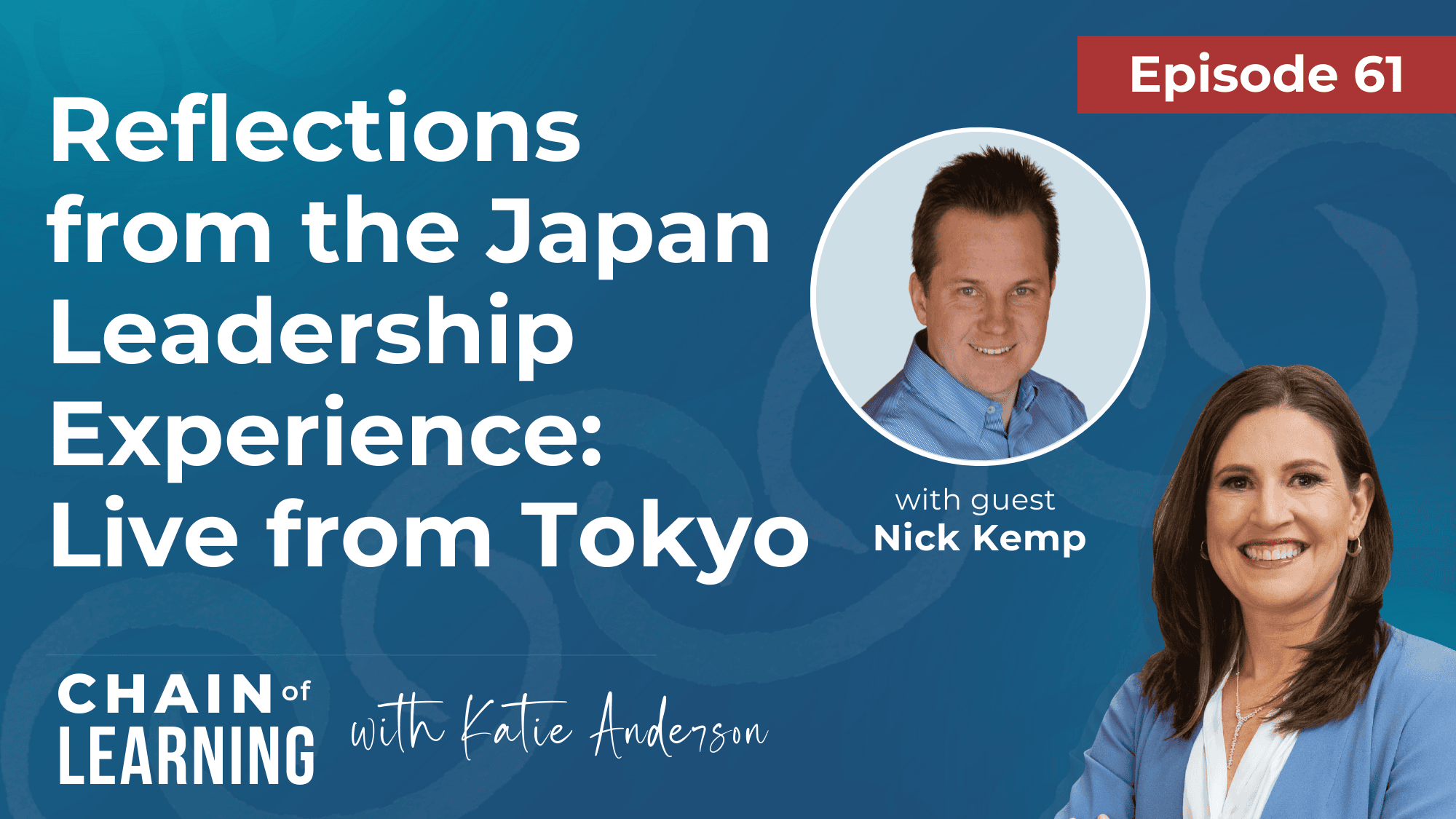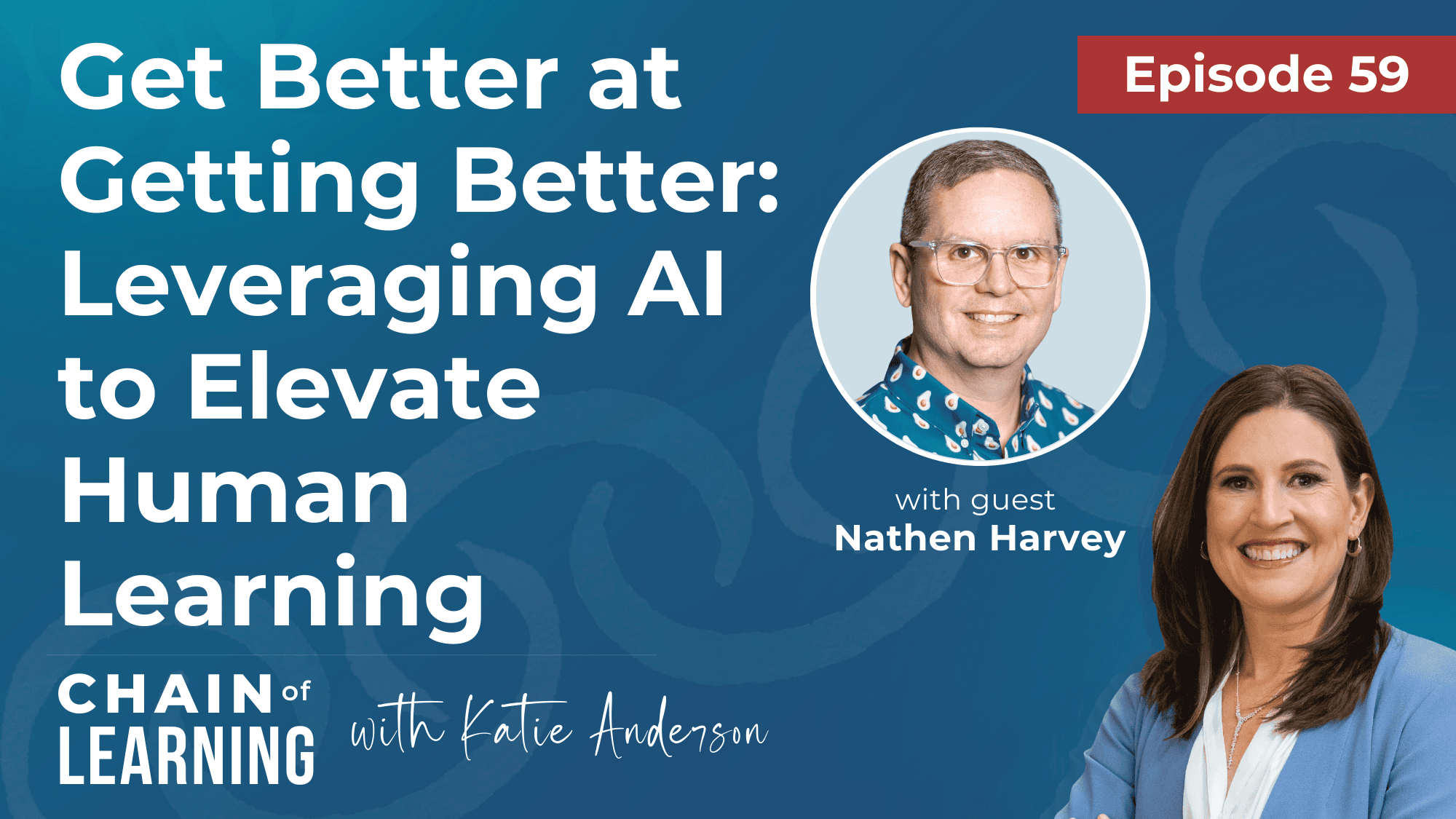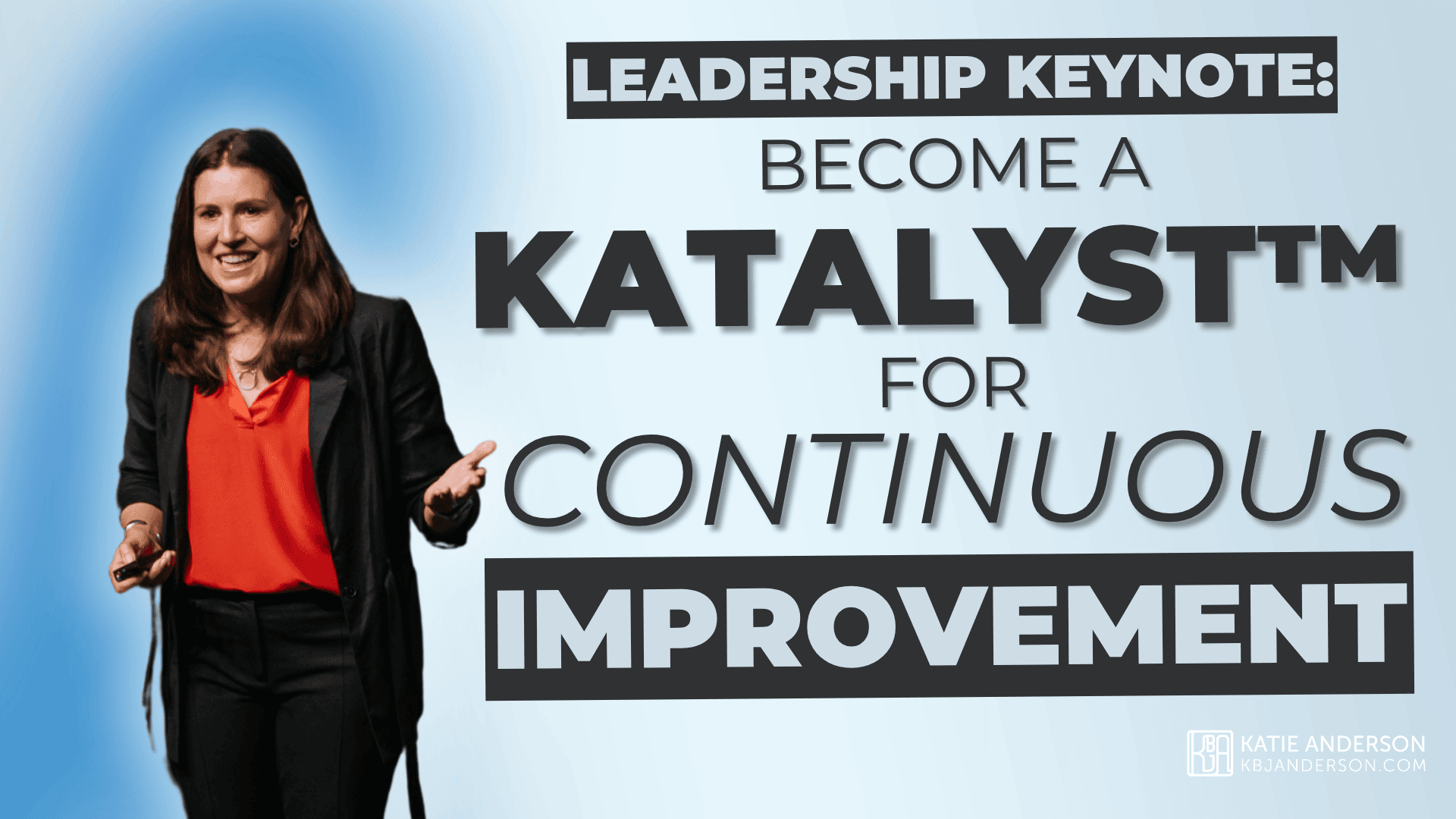How Toyota Rebuilt Alignment—and Leadership—From Within
A global economic crisis is dragging down sales.
Departments are working in silos and leaders at all levels are arguing about priorities.
Managers are too busy to coach their teams.
You might think this describes your organization today—and it was the exact situation Toyota faced nearly 50 years ago.
This challenge sparked one of the most ambitious and influential—and least known outside Japan—leadership development programs in Toyota’s history: the Kanri Nouryoku Program, or Kan-Pro for short. “Kanri” meaning management, and “Nouryoku” meaning capability.
Kan-Pro helped establish the people-centered learning culture Toyota is famous for today and embedded A3 thinking as a foundational process for problem-solving, communication, and leadership development.
I invited Isao Yoshino—a 40-year Toyota leader who was one of the key team members who helped create and lead the program—back to the podcast to share his experience in two pivotal moments in Toyota’s evolution and how he learned to lead cultural leadership transformation from a place of influence, not authority.
Join me and Mr. Yoshino—also the subject of my Shingo-award winning book Learning to Lead, Leading to Learn — as we celebrate its 5-year anniversary this month!
In this episode, you’ll learn:
✅ The problem Toyota was trying to solve—and how Kan-Pro emerged as the countermeasure
✅ The leadership styles of Masao Nemoto vs. Taiichi Ohno—and how both shaped Toyota’s culture through the development of Toyota Way management culture and the Toyota Production System
✅ How Mr. Yoshino learned to coach and develop more senior executives as a mid-level internal change leader
✅ The process that established A3 thinking as the standard for leadership development, communication, and problem-solving across Toyota
✅ Critical leadership behaviors that led to Toyota’s success—which have come to be known as “lean management”
Listen Now to Chain of Learning!
Tune in to hear how Kan-Pro helped shape Toyota’s leadership culture—and what you can apply to your own organization today.
Watch the Episode
Watch the full conversation between me and Isao Yoshino on YouTube.

About Isao Yoshino
Isao Yoshino, worked at Toyota Motor Corporation for over 40 years—from the late 1960s to the early 2000s—and played an important role in the development of Toyota’s people-centered learning culture it’s now famous for. He was a key part of Kan-Pro senior leadership development program, which embedded A3 thinking as the process for problem-solving, communication, and leadership development across the organization—and has deep expertise in the practice of hoshin-kanri—Toyota’s strategy deployment process.
Celebrating 5 Years of Learning to Lead, Leading to Learn
At the time of this episode’s publishing I am celebrating the 5th anniversary of my award-winning book Learning to Lead, Leading to Learn. For those of you who do not know, Isao Yoshino is the subject of my book.
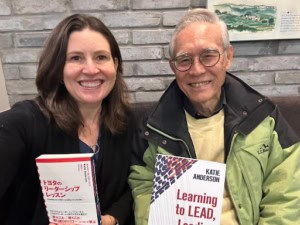 In July 2020, I had the honor of sharing Mr. Isao Yoshino’s stories with the world through Learning to Lead, Leading to Learn. What began as a professional connection has grown into a deep friendship and partnership rooted in mutual respect, curiosity, and a shared commitment to leadership and learning.
In July 2020, I had the honor of sharing Mr. Isao Yoshino’s stories with the world through Learning to Lead, Leading to Learn. What began as a professional connection has grown into a deep friendship and partnership rooted in mutual respect, curiosity, and a shared commitment to leadership and learning.
Mr. Yoshino’s wisdom continues to inspire thousands of leaders around the world—and I’m continually learning from him too. I’m so grateful for our more than decade-long journey together and the impact this book has made.
Here’s to five years—and to the ongoing Chain of Learning® we’re building together.
If you have read my book and it has sparked new insights or inspired your leadership journey, would you consider sharing your hansei — your reflections — by leaving a review on your preferred online retailer’s website, reading community, or LinkedIn?
 Your review is social proof of the book’s impact and helps more leaders around the world discover the power within these lessons.
Your review is social proof of the book’s impact and helps more leaders around the world discover the power within these lessons.
If you have not read the book, consider purchasing a copy for yourself (or for your team!) – available in paperback, hard cover, audiobook, ebook and has been translated into eight languages.
Learn more about where you can purchase a copy here: LearningToLeadLeadingToLearn.com
Why Mr. Yoshino Joins the Japan Leadership Experience
In this episode, retired Toyota executive Isao Yoshino shares why he continues to participate in the Japan Leadership Experience year after year—not just to share lessons from Toyota, but to keep learning himself.
“I want them to learn something from Toyota,” he says, “but I also want to learn myself.” Mr. Yoshino reflects on how the insightful questions from participants push him to think more deeply, how their curiosity sparks his own reflection, and how the experience keeps his mind sharp and spirit young.
This is more than a tour—it’s an immersive leadership learning journey where wisdom is exchanged, not just taught.
Want to be part of this transformational experience?
Join us for the next Japan Leadership Experience this November 2025.
What Made Kan-Pro Transformational for Toyota’s Culture
In the early 1980s, Toyota’s top leaders saw a decline in alignment and leadership focus. Departments were siloed, and managers weren’t developing their teams. Kan-Pro was created to “tighten the screws” and prioritize people development as a strategic focus.
Kan-Pro—short for Kanri-Nouryoku Program—was a leadership development initiative aimed at strengthening senior managers’ capabilities. Unlike broader programs like hoshin kanri, Kan-Pro required each leader to create their own A3, clarify key goals, and take ownership of developing their team—with coaching and support from top executives.
The program helped managers align priorities across departments and build stronger relationships through shared learning.
For Isao Yoshino, then a young leader supporting the program, Kan-Pro was a turning point. He deepened his understanding of A3 Thinking, learned from senior executives like Masao Nemoto, and discovered what it means to lead by supporting others’ growth. It was leadership development, modeled at every level.
Reflect and Take Action
Real culture change starts when leaders make it a priority—not just in words, but in action.
It takes courage, clarity, and consistency from leaders at all levels to set direction and support others in doing the same.
Transformation isn’t about handing people a vision and expecting them to follow. It’s about creating the environment where they can make it their own. That’s what Toyota modeled through Kan-Pro, and what Mr. Yoshino experienced firsthand and the same principles still apply today.
As you reflect on your own role as a change agent in your organization, ask yourself:
- How can you bring others along on your vision for change?
- How can you be a yes-minded persuader and a transformational improvement coach—helping others take ownership while you support their growth?
These are essential skills for becoming an influential change leader.
Where in your organization do you need to stop pushing and start creating space for others to grow into the change?
Important Links:
- Full episode show notes with links to other podcast episodes and resources
- Check out my website for resources and ways to work with me
- Follow me on LinkedIn
- Download my free KATALYST™ Change Leader Self-Assessment
- Learn more about the Japan Leadership Experience
- Read my book featuring lessons from Isao Yoshino’s 40 years of Toyota Leadership
- Episode 21 | Leading to Learn Part 1: Build A Chain of Learning with Isao Yoshino
- Episode 22 | Leading to Learn Part 2: The Power of Reflection with Isao Yoshino
Listen and Subscribe Now to Chain of Learning
Listen now on your favorite podcast players such as Apple Podcasts, Spotify, and Audible. You can also listen to the audio of this episode on YouTube.
Timestamps:
03:51 The leadership shift behind the Toyota Way in the 1970s towards a people centered approach
06:03 How Taiichi Ohno shaped the Toyota Production System and Masao Nemoto shaped Toyota Way style leadership
07:41 Closing Toyota’s leadership gap and how Kan-Pro emerged as a countermeasure
12:41 Why committed top-down leadership ownership is essential to creating organizational culture
14:46 How seriousness and patience sets Toyota apart
15:17 Why Toyota created Kan-Pro to ‘re-tighten the belt’ on leadership capabilities and why they need to refocus on leadership capabilities every generation
18:55 The leader’s role in setting direction and providing support to their people
20:40 The mindset shift in top management to not to fake it and pretend to try and work hard
21:17 Mr. Yoshino’s experience coaching senior leaders through hands-on A3 learning
25:38 Key influence skills Mr. Yoshino learned from great Toyota managers
28:12 The importance of respect by senior leaders even when there’s resistance to change
28:58 Being a Yes-Minded Persuader – a key KATALYST™ Chang Leader competency – in bringing leaders along in change
31:25 Lessons from coaching senior leaders using A3 thinking during Kan-Pro
35:45 The positive shift when leaders prepare the A3 themselves
37:48 How having to share their handwritten A3s to senior executives was critical to their buy-in to the Kan-Pro leadership development program
41:13 The significance of a leader stamping their hanko on an A3 document and what it represents in a leader’s responsibility as a coach to develop their team members
43:35 Why reviewing an A3 at Toyota is different compared to most companies
45:16 Mr. Yoshino’s highlights in participating in Katie’s Japan Leadership Experience lean management tours
48:29 Leading change involves empathy, patience, and helping others change themselves
48:50 Questions to reflect on as a change agent in your organization
Full Episode Transcript
[00:00:00] Isao: Mr. Sugiura is always work hard for top management. Same time, he’s ready to give me a opportunity to learn something directly. So, uh, I determine that when I become the manager of the role, I will do the same thing as he does to me.
[00:00:18] Katie: Welcome to Chain of Learning, where the links of leadership and learning unite.
[00:00:21] This is your connection for actionable strategies and practices to empower you to build a people-centered learning culture, get results, and expand your impact. So that you and your team can leave a lasting legacy. I’m your host and fellow learning enthusiast, Katie Anderson. A global economic crisis is dragging down sales quality issues are mounting departments are working in silos.
[00:00:44] Leaders at all levels are arguing about priorities. Managers are too busy to coach their teams. Sound familiar. You might think that I’m describing your company today or one you’ve worked with, but this was the exact situation Toyota Motor Corporation faced nearly 50 years ago in the late 1970s, just a decade after winning the Deming Prize, Toyota’s executive team recognized that operational problems were symptoms of a deeper issue, a gap in senior management capability.
[00:01:14] Leaders weren’t effectively setting or aligning on strategy. The hoshin kanri process, which I explored in detail two episodes ago in episode 45, and they weren’t developing their team members’ problem solving and communication skills. The countermeasure, one of the most ambitious and influential and least known outside of Japan leadership development programs in Toyota’s history.
[00:01:36] The Kanri Nouryoku Program or Kan-Pro for short. Kanri meaning management and Nouryoku, meaning capability. Kan-Pro was a two year initiative launched in the late 1970s and early 1980s designed to re-tighten the screws on the leadership behaviors and thinking processes of Toyota’s 1000 most senior managers. The outcome, A foundational shift con Pro established the people-centered learning culture.
[00:02:02] Toyota is famous for today and embedded a three thinking as the process for problem solving communication and leadership development. One of the key team members responsible for developing and leading the program, though still early in his career, Isao Yoshino, a 40 year Toyota leader, and the subject of my Shinga Award-winning book, learning to Lead, leading to Learn, which this month celebrates its five year anniversary.
[00:02:26] I invited Mr. Yoshino back to the podcast to explore two pivotal inflection points in Toyota’s evolution, not just to recount these significant milestones, but to reflect on how he learned to lead cultural transformation from a place of influence, not positional authority. This episode is the first of two parts from our conversation recorded.
[00:02:47] Just weeks after spending an immersive week together in Japan on my most recent Japan leadership experience. Here in this episode, we focus on Kan-Pro and how Toyota’s senior leadership, especially President Eiji Toyoda, senior leader, Masao Nemoto, and Mr. Yoshino’s boss and mentor, Mr. Sugiura set out to reshape Toyota’s leadership culture and how Mr.
[00:03:07] Yoshino as an internal change leader learned how to coach up senior leaders and influence wide scale transformation. The second part of our conversation will feature in an upcoming episode of Chain of Learning, we’ll explore Mr. Yoshino’s next major assignment to change the culture. And how he and his team, including Lean Global Network Chairman John Shook led the training program in transformation of frontline American leaders at Numi, the GM Toyota Joint Venture in the 1980s.
[00:03:34] You can read more about both of these impactful events in Toyota’s history with Mr. Gino’s behind the scenes stories and learning to lead, leading to learn. And if you haven’t, go back and listen to episodes 21 and 22 of this podcast to hear Mr. Yoshino’s powerful reflections on leadership and what it means to create a chain of learning.
[00:03:51] To begin this episode, I asked Mr. Yoshino to reflect on the influence and style of two key leaders, Taiichi Ohno and Masao Nemoto in the development of the Toyota production system and Toyota Way management. In the intentional shift, Toyota made towards a more Emoto style people centered approach to leadership in the 1970s.
[00:04:09] Here’s Mr. Yoshino.
[00:04:11] Isao: Well, actually, when people say Toyota way, uh, sometimes people are talking about production site. Like kaizen or those, just like, uh, Toyota has been, uh, working very, very hard, but when Masao Nemoto came in, the Neol, NTO area is not necessarily the, the working, they was particularly manager, but he’s focusing on Manal level.
[00:04:36] So the area that Taiichi Ohno is focusing and area of Nemoto is focusing different. Probably, probably easy. Toyota just, you know, expect that taking care of the production, direct production side, everything. Manufacturing side. Then he assigned Mr. Dito in directly property. You take care of, just like Taiichi, you take care of the management.
[00:05:03] Oh, managers level, just like another party owner. So just so Mr. Nemoto intentionally doing the totally opposite way of doing things. Though he yell out, but always, always nice smile, nice and accept everything. And so it is very, very interesting. Hardcore Tai style, less soft spoken and, uh, Mr. NATO style. And uh, it’s all those two pillars work very closely together.
[00:05:33] That is the reason why we Toyota people are very, very lucky. And, uh, on the production side, very great people. Then the motor is, is a, is is very good listener and always ready to listen. So, uh, we have those great directors and working on both sides. We are very, very lucky. I don’t know whether we have that type of two pillars in, uh, in the current Toyota.
[00:06:01] Organization. I don’t know.
[00:06:03] Katie: Well, the legacy that they have left is strong. All of you know, the, the production principle concepts that Taiichi Ohno really embedded in like the, you know, oh yes. Really created with the Toyota production system and then Nemoto’s approach around what we know and talk about on the, the coach.
[00:06:18] The leader is coach and as you said, asking questions, really knowing how to negotiate and communicate and align from the management side. And, you know, there, there was. A real decision on that. That was the direction they wanted to go from a management perspective. More of this Nemoto style.
[00:06:37] Isao: Mm-hmm. Right.
[00:06:38] So it was the, we are very, very lucky. I, I personally very lucky because, uh, when I was, uh, with Toyota, IT owner, it’s so popular. At the same time, NMO came in and came up with another big pillar on maybe on office side or management side. So that, uh, that makes Toyota the big, uh, you know, some so successful and, uh, and that, so, so that, tell us a lesson that, you know, uh, why Toyota has been so successful.
[00:07:10] Because of the seriousness of a top management and always they keep that seriousness, uh, forever. And then the people working for them. Automatically becomes so serious because it starts from top management. If top management, they lazy, you guys do this, then nothing happens. Maybe it works in one year or two years.
[00:07:31] But it’s within Toyota. Just, you know, uh, it, it lasts longer because top management always serious.
[00:07:41] Katie: Based on this intentional shift in leadership culture in the gap’s, Toyota’s executive team saw emerging in their senior leaders’ capabilities. President a j Toyota assigned Masao Nemoto to lead the effort to close the management capability gap.
[00:07:54] Nemoto in turn appointed Mr. Yoshino’s boss, Mr. RA, to lead the charge in re-tightening the screws on the leadership practices of Toyota’s top 1000 senior managers, including general managers and assistant general managers who reported up to the executive team, which Mr. Yoshino often refers to as board members or senior officers.
[00:08:13] I asked Mr. Yoshino describe the problem Toyota was trying to solve and how Kan-Pro emerged as a countermeasure. Let’s dive back in. I’d love for you to share a little bit more about what problem the Toyota Senior executives were seeing in the 1970s and then what, what Con Pro was all about.
[00:08:31] Isao: I’d say that’s a, that’s a good question because probably in, uh, in, uh, 1950s and sixties, we learned so many things out of, um, American, American lean coaches like, uh, Dr.
[00:08:42] Deming and their group. So Toyota, all the people, Toyota Manage Management people are so eager to learn something new and they are so excited that they’re doing things right just like they learn in, in maybe sixties, but 10 years, 15 years later, they think they are quite familiar. They’re an expert on doing what they have learned from the United States.
[00:09:07] And also Toyota is now expanding and bigger and become number one in uh, o old companies. So then they become, oh, we are great. We clearly is great. We have nothing to learn from somebody else. So it become arrogant. Arrogant is a very strong expression, but kind of they believe that we reached the goal already.
[00:09:30] They don’t say that. They did not say that, but top management is Toyota Top Management. He felt that probably their energy, not energy, but the intention. Was good, but still their excitement when they learn something new from the United States is now it’s slowing down. It’s fading away a little bit. They sensed it.
[00:09:53] Top management sensed it. And also the recall thing. All those things happened then in, in the old market too. So top management became concerned about those mentality, about those, you know, number one in the world, in Japan and type of thinking. So what. Management was become so serious, uh, to begin with, not, not secure as a group management.
[00:10:17] So they talk about it in, in among those top management. And that is, I believe that is how it started. They don’t call it at that time yet. Each daughter was talking with, uh, Mr. Nito. We just like, uh, he, Mr. Nito is just like, uh, I. I only is the manufacturing side, but NTO is on non-engineering, not an, uh, a manufacturing area.
[00:10:44] Anyway, talk to Mr. Nto and, and the, okay, this is what my feeling, maybe it’s the energy and the excitement is fa away. So then Mr. Nto said, I hundred percent agree, agree with you. So top management becomes so serious. That’s so powerful. It’s not that, okay, you guys do that? No, no. Top management’s serious about it.
[00:11:10] They talk with each other. Then Mr. Nemoto came down to mr. And okay, this is what top management, including me very much worried about. So what that is, beginning of the comfort, they don’t call it comfort, but we have to do something. Then Mr. Just discuss about it and, uh, lot about, lot of talking with other key keyboard members.
[00:11:39] So they decided to teach high highest ranking general managers level teaching, just like we trained newcomers in university graduate. So that is how it started. So that shows. Top management is always serious about, about our companies and also abouts of people working in that, uh, community. And so, uh, those seriousness of top management is really the trigger of that.
[00:12:11] And, uh, so that’s why all the general manager of people. When they start complaining, how come just you treat us just like a small kid. Always Mrs. Responded. I know. I know how you feel about it. But it’s come from the top management. They are so serious. Then we have to be serious just like they are. So then those people who is that right?
[00:12:36] Maybe then. Probably they’re all right. So what
[00:12:41] Katie: you always talk to me about how, you know, the Toyota’s success come from being both a combination of top down and bottom up at the same time, and people working in companies aren’t as fortunate to have senior leadership who are as serious and committed.
[00:12:57] You know, as we’ve talked about in the past, uh, about the direction of the company and in developing people. Mm-hmm. How, how much do you believe from your experience, that that top down seriousness from the senior leaders is essential to really creating the culture that they want?
[00:13:13] Isao: Because top management is a decision maker, so they have to make a very, very difficult, difficult decision all the time.
[00:13:20] So, uh, if we have the terrible, terrible, stupid guy on the top, management. Then it’s, it’s very scary. So we, all the employees, including me, feel very happy. Okay? Our top manager is very serious about the company. At the same time, about the people working here, including us. So we feel very happy to have those guys very, very serious people up there.
[00:13:47] Then why not we workers underneath, working underneath those people. We have to work just as hard as they do. So, uh, we see those seriousness up there, then it’s easy for us to start something by us. And it’s, it’s, it’s natural because. If your father and the mother is very serious about taking care of the kids, then kids really appreciate if what happened if a father’s mother don’t care about the kids and they fool around everywhere.
[00:14:18] The kids, sometime when they kids grow, then become wired or some just they was thing will happen to them. So you cannot blame the kids because they learn, they watch their leaders all the time. Same thing in the company. That’s why Toyota has been so successful in, uh, attaining something as a big group because seriousness is a key word of Toyota.
[00:14:46] And, uh, so there is no, no huge difference between, uh, between the car quality, whatever. Look, car quality is the same. Nissan, Honda, Toyota car quality is hideable. But the mentality, way of thinking of top management is always serious. About the people, about their responsibilities. So seriousness. Uh, maybe another thing is the patience, but seriousness and patience is, uh, is, uh, is the area that Toyota is slightly different from other companies maybe.
[00:15:17] Katie: So let’s go back to Kan-pro. So senior leaders told you that this was very important and they needed to real, you’ve told me like re-tighten the belt on management practices, which Right. Toyota’s really had to do almost every 20 years because of generational changes. And, you know, what was this program that you and your team and Mr.
[00:15:37] Sura, what was it that they ultimately, or you came up with? Um, how long was it and what was its purpose?
[00:15:45] Isao: It’s very interesting. You know, it’s, uh, of course the top management did not tell us lot of details, but we top said we have to train our employees again. When we top manager said, when we train our employees, that means not working level at decision maker, which is general manager’s level.
[00:16:06] So that was that one, one of the first thing they, we, we received from top management. So we are so surprised. Okay. General managers are very smart people. They looks like they know everything. How come we need to train them? We need to provide some training for them. So it’s not the knowledge that they lack, but attitude or way of thinking.
[00:16:28] They lack. So it’s not the knowledge, but it’s, it’s a, it’s their mindset. And so Mrs. C is very sharp and he understand that he, he can sense it because he was a, at the time he was a manager, not high level, but manager at the time. And we are younger. He was younger, yeah. So, but he was so close with Mr. Nito, so he, so much time with Mr.
[00:16:54] Dito and uh, and the Mr. Dito is very, also very serious and so. You know now since all those seriousness of top management, then they talk about how many years? Not one year, but it’s maybe two years. Of course. Two years maybe finally decided. But top management, probably one year or something. See, usually training.
[00:17:18] Takes into three weeks, or four weeks, or two months, three months, but it’s one year still because poaching can take place January and the end December, so one year. But, you know, uh, Mr. Namo top management said maybe one year, then it, it’s, maybe they can learn something, but it does not stay in their mindset forever.
[00:17:38] So make it two or two years. So, uh, top management makes some decision. That does not necessarily mean that, okay, you guys do that until we just wait. But they become so serious. Board members become so serious, and that is one of the things we found out through Mr. RA’s information. She know just, you know, all those, all those board members are so serious about it, then why not us?
[00:18:08] So it’s automatically those. Sense of feeling came down from so smoothly. It’s not that, okay, you guys are lazy, so you are, you have to work harder. It’s not that top management is becomes so serious and so what normally complains about it a little bit small complaint, but it’s not a serious complaint. So, uh, that was, uh, one of the first time that I ever, you know, found out that.
[00:18:38] Asia, Toyota, and those, those board members are so serious about the future of Toyota. Not current situation, but future long term, 10 years, 20 years. Anyway, so, uh, we have the right person, Mr. Mr. Nato, without them that. Not happen
[00:18:55] Katie: and really setting that direction. You know, as we talk about the, the leader’s role is to set the direction, which is what they’re doing.
[00:19:01] This is the direction of the, the culture and the management, uh, style that we want here. Yeah. And, and then provide that support, which is really what Kan-Pro was. I love your, your comment that’s in the book that you said Mr. Sugiura said two years is too long to fake it and pretend to try and work hard.
[00:19:19] Isao: He was, he was joking about it.
[00:19:21] Actually, that is really great comment because, because everybody wants to, you know, goof around because they went, pretend that they’re working hard but years. So they decided two years I cannot do that. So it was very interesting. Of course, two years is too long because you have to create your history document by yourself, by hundred written four times within two years, see?
[00:19:48] So it’s not easy. So, uh, that is a very, you know, powerful, uh, requirement for auto general managers. So they have to become so serious. They cannot assign to their subordinates to write it for them. No, they cannot. Handwritten. And also we know that top management’s so serious. So very often we, we get the top management comment and then send it to all the general managers, whatever, in order to make sure that we are on the same page.
[00:20:16] It’s not that top management says something and don’t do anything, but it’s not top management. Always curious about what’s going on with that control and so on. We, uh, update with them since the same time we shared, uh, our plans to all, all over the headquarters area. So it’s a communication is very, very, you know, uh, quite often.
[00:20:39] And, uh, so, uh, there is no, no negative reaction for them because those general manager level, they already knew that they need to be trained in some way in their deep, in their mindset. We are kind of losing an energy, losing some, you know, goals. So they already noticed of themselves. It was very good timing.
[00:21:02] Top management started talking about it. Then general manager, they think, you know, we are a little bit, become a little bit lazy, so it’s knees matches. Yeah. It’s very, very interesting.
[00:21:17] Katie: Yeah. And you were playing a really important role to support all of these. Senior leaders across the organization to learn and practice really what, you know, what we now know as A3.
[00:21:28] Thinking that they had to create their own A3’s, present them to their, you know, to the executive team, get coaching and, and really, and do it themselves. So talk to me about what your experiences was. Like about being part of that team and, and sort of leading this training and development for all these senior managers across the organization.
[00:21:48] And, and so you were really leading change, but leading through influence because you’re coaching them rather than being the manager telling somebody that they needed to do an A three.
[00:21:57] Isao: Well, actually, actually I was, I was younger and Mr. Mrs was a key person, so those general manager don’t call, did not call us directly, but call Mrs.
[00:22:07] First. So that, that I was sitting just beside him so I can listen every single word they are talking about on the phone and at the beginning it’s very, very interesting. You know, Mo, most of the general managers are high level, so Mr. Sri is manager, so to, to rank lower. So they are kind of complaining just straight, Hey, hey, just, you know, this, you guys just make us so busy and we are so busy.
[00:22:35] So how come just you add more. Another assignment to us, but they are kind of serious, but jokingly. But Mrs is very, very soft spoken. He said, yes, sir, I a hundred percent agree with you. However, this come, the pop management is so serious, sir. Of course. They are so serious. We have to be the, we have to become so serious as the same day as stock management.
[00:22:58] That is what we need to do. And so then all those people said, yes, I, I understand that. So Mr. Ra is very soft spoken and, uh, he, he, he just knows how to respond to those people. And, uh, so sometimes they say very strong words and Mrs. Oh, yes, yes sir. Yes sir, you are right. I agree. And so what? I was, I was enjoying so much the way he responded to them.
[00:23:27] So he does not, he does not compete with them. He just, he accept everything, all those complaints. Yes, sir. It was, you are so busy. And so it’s very, very interesting experience for me to how to respond to hardcore, you know, talk from somebody using their position and, uh, look down to us. Look down to Mr. But Mr.
[00:23:50] Syria nicely respond to them. So I learned how to talk back with them in national manner and, and ended up with, uh, satisfaction on their side. So it’s a great way, even, even, we don’t even start anything, uh, at the very, at the Be this states. I was so impressed with the way he communicate. He’s a very good listener and uh, but he knows very whenever we meet.
[00:24:19] For example, when we meet, we meet an in person general manager level. In the technical division, for example, he, he knows, he knows so many things about this guy. So he always, um, uh, um, try to make him feel happy to speak up something. He knows how to treat people. And so, uh, I was, I was so excited that joining him and, uh, he, me, the what.
[00:24:47] So boss says, I would like to join you. So what for? Yes. You know what, what for? I want to learn something. Why? Why does that guy, their manager in the technology division on what they talk about you, how they, how they respond to you? I, I just want to hear on your side. Anyway, so Mrss just wanted to help me out to learn something.
[00:25:09] He’d always bring me, you know what, you’re gonna join me and we gonna visit. So. He, Mrs. Is always ready, work hard for top management. At the same time, he’s ready to give me a opportunity to learn something directly. So, uh, I determine that when I become the manager of Will, I will do the same thing as he does to me.
[00:25:34] I think he’s one of the best managers that was in Toyota.
[00:25:38] Katie: And what a great manager for you to not only develop management skills of how you wanted to treat people who were reporting to you, but what I heard in what you were just sharing is he, he taught you a lot about the key influence skills. You need to, as you said, like speak to more senior managers if you’re trying to coach and develop them, how to bring them along and how to hear their complaints.
[00:25:57] Or are there challenges, but still like to hear them but still help move the change forward or the initiative that needs to happen? Yeah. So
[00:26:05] Isao: yeah, again, one of the great thing about Mr. S is that whenever that other complain about it, Mrs. Always accepted, yes sir, you are right. I, I understand what you’re talking about.
[00:26:18] I understand, sir. However, there is that is maybe it’s troublesome. How about there is more benefit of this one, and he just talk about it. And, uh, then that guy, of course, they know that, so they got, oh, I, I know Mr. Uh, I know that, I know that, but you know, I just complain because I have so many things to worry about.
[00:26:42] So he always, Mr. C, always accept something. Then in turn, in return, he gave his comment back to them. So it’s not only accepting all those complaints and thank you, sir, but he just always send back his comment and uh, make it even kind of, so it’s a very, very interesting, it’s not a technique, but his working style and, uh, he always try to be a good listener.
[00:27:12] It’s, it’s amazing. And when they, they are talking. When those people just want to complain and give complaint to every complaint he has in mind to tell them, Mr. Just patient, listen to them and put it in writing. And so I was so impressed. Why this guy don’t get mad. This guy does not get mad because still he is, always listen to them.
[00:27:39] So our patience is a great virtue when it comes to something, uh, this situation. So, uh. Done so many things, how to talk back, how to explain something. But, uh, he always start, yes, always. I agree. He was so busy. I agree with that. And, uh, then he express his opinion in return. So, uh, that makes, uh, their, their counterpart feel happy that, oh, you is now listening to me.
[00:28:12] He is listening to my complaint. Then I have to. And I have to listen to him in return something. So that is one of the things I learned from him. One, the many things I learned from him. So, uh, giving your opinion directly to them does not accomplish any, not so many good things. You, you have to accept, uh, because everybody, those high rank people just, uh, you know, very proud of people.
[00:28:37] So, uh, we have to accept them. Oh, you are, you are so busy. Every, whatever they said, Mr. S said, yes sir. Even though it’s a terrible comment when it says, yes sir, I understand what you’re talking about.
[00:28:52] Katie: That’s such an important skill and even the words you’re using align with one of the eight competencies I talk about.
[00:28:58] My catalyst change leader model is being a yes minded persuader now, and that’s not necessarily that. Persuade and force your opinion on someone, but it’s, but how do you say yes and, and help bring people along? Sound like Mr. Sugiura was a master at being a yes minded persuader.
[00:29:13] Isao: Right, right. And of course he probably, he learned those way of doing things.
[00:29:19] Mr. From Mr. Nto, our boss, because Mr. Nto is very proud of. He, he, he told us that I have never yelled out anything to subordinate in my entire life. I always accept something because if they, somebody says something, something bad, something, but there should be some reason why they talk so bad. So Mr. Nto is similar, what you are thinking of Mr.
[00:29:47] Sugiura maybe try to become a number, you know, the same as Mr. Nto. So he has his own target. I want to be just like nto. So he joking. They said I’m, I’m the, uh, professor of the Mr. Nto NTO school. That’s what he says. So, uh, he has, he puts some target by himself. Mm. I want to become just like Mr. Nato, but in my own style.
[00:30:15] Mm. So I, it is, it was very, very interesting. So just by, I learned that, so that I want to become, uh, professor Mr. Ra. I want to become just like him. So it’s passed down. Those wave, think passed down from the motor to, to me and for me. For me to, or whatever
[00:30:34] Katie: that, that’s really what that chain of learning is, right?
[00:30:37] Isao: Exactly.
[00:30:39] Katie: Well, during Kan Pro, general managers were required to develop and present A3’s four times over the two year initiative. But it was far more than just about writing reports by observing how his boss, Mr. Sugiura, senior leaders, many of whom outranked, both of them, Mr. Yoshino, gained invaluable lessons on how to coach up and lead through influence rather than authority.
[00:31:00] Listen in as he reflects on what it really takes to bring others along without pushing them. A few more questions about Kan-Pro. So you were, you know, I, my understanding from our discussions and RA writing the book is you helped support these senior managers in developing their a threes in preparing for their, uh, you know, their presentations, their discussions with the executive team and giving them comments and feedback.
[00:31:25] What were some of the things that you learned about creating A3’s or coaching leaders through that process of the two year Kan-Pro program?
[00:31:36] Isao: Those general manager 45 words above, so they’re already high up there and order, so it was the very first time in their life to, again, not first time, they’re younger.
[00:31:51] When they’re younger, they start riding a three, but not so. Now comfort. They have to prepare a three document by themselves. There’s no typewriter, no, no computer, laptop, computer. We, we didn’t, they have to prepare by their own hand. So it was very first time in the, in their entire life to go back to those 20 in the twenties.
[00:32:15] So, uh, they are struggling all the general managers because they, every single day they don’t write any document, but they just, there. Make some judgements and decision making, but all of a sudden, under two years 79 and 80, they have to prepare each three document themselves. But their reaction is very interesting because at first they, they, they, they call us in our team that, okay, you guys just, you guys, you know, let us out, prepare all of the history documents.
[00:32:47] Just like our school kids, they start complaining jokingly, halfly, but when they start. Doing that. They relearned what, how to put this information to this, which portion of the A3 they relearned just like they are younger generation. They learn newly, so it’s a good benefit for them. They started recognize it.
[00:33:10] It, I’m consuming for me, but the same time, this is really very important for me to, as a general manager, to, to define what is the most important thing. And again, somebody is less important so they can learn something important at the general managers level through preparing the E three that what, what they, they told us directly or indirectly.
[00:33:35] It’s very, very interesting, but total general managers very nice people, very smart people, but they’re kinda also proud people. So, uh, at first they did not like it preparing. However, they have to think about something by themselves. What is my role is then they have to put down in the S3 document. Nobody, nobody can do that except by themselves.
[00:33:59] So, uh, it’s very, very interesting to see their attitude changes at the beginning, but maybe six months later. Their attitudes, uh, changed a lot. It’s very, very intense. First, first couple months they keep complaining, sending the elephant, complaining, articulate to, to me, to us younger. Just, just tell us, do this.
[00:34:23] Please prepare this history and, and prepare presentation. But I have to spend so much time working on that. They start complaining. However, after couple of couple months, they recognize that. They need to relearn how to, how to put all the key on the key things. On the A3 document, they start started relearn, they relearned how important it is to address their key point on the A3 document.
[00:34:54] So anyway, they relearned something new. So after maybe 3, 4, 5 months later, they, the way they caught us is different. Know, just this is pretty good. This is pretty good. But I, I just, uh, have some question. I, I wrote this one, but do you think this is important to our, so sometimes they ask us questions, so, so they, they was sometimes negative, but the beginning.
[00:35:24] But after they go through the process, they become a more positive. Because they now recognize how important sharing those history, preparing history themselves and sharing with other people, doing by themselves is so important. So we witness all the hinges take taking place in the F, particularly first six months.
[00:35:45] It’s amazing. So that is the power of a good program. And uh, when I say good program, that means. They have to prepare their own A3 by themselves. They that not assign their subordinate to prepare it. They cannot because it’s handwritten, so it’s not type typewritten. Anyway, so that was very, very good and they become much, much clear what is their responsibility is and, uh, they learn so many things in the, particularly in the first six months, that is what Mr.
[00:36:20] Sugiura already imagined. So it was very, very interesting. Those comments coming mean to our office. Changes from, I know negative comments and complain, but become more positive. And, uh, sometimes they ask some, some, my hint from Mr. Sugiura and um, even to us. So that makes us feel so good because they were start as a negative, they become more positive.
[00:36:51] We did not force them to change, but they changed themselves. So that is the power of the concept. It was, it was a, a fantastic experience for us to learn that, oh, we have so many excellent and, and German as level of people. I feel very, very happy to. Be in that, in that, uh, department.
[00:37:14] Katie: What an incredible experience to get to attend lectures by Mr.
[00:37:18] Nemoto,. Working directly with your best boss of your lives and seeing him as a really influential change leader of how he was responding to the general managers and coaching them. And you were learning in that same way for yourself as well. Hmm. And one of the, you know, I can imagine too that the senior leaders, as you said, the executive team, the, the directors being so serious as well and that the senior managers had to share their handwritten A3 to those senior managers at the review.
[00:37:48] And so I imagine that gave them some pressure.
[00:37:51] Isao: Exactly. Because. Those board members underneath board members or dinner managers. So board members who is in charge of the certain department board members needs to make some comment. When they make some, they prepare and, uh, in 10 minutes presentation, they have to make some comments.
[00:38:10] They have, they have to be serious about, about reading all those, some, some, you know. Level. So board members also, they learn so much if they make some stupid comments and it’s, it’s so ugly, see? So they have to go through that quickly. And then judging from his own idea and own experience, they have to make some nice comments to them.
[00:38:37] So at, at the beginning, both members called Mr. Sugiura from time to time, they’re worried about how to say. How make, when, when you guys advise those how to create history, how do, how did you do you do that? So they ask Mr. Sugiura hint how to make some nice comments so board members become so serious. Yeah. It’s very, very interesting board members that maybe 45, 5, 50 years and they are so, so smart.
[00:39:11] But still they are, they when they did not go through the process before, before, uh, uh, before the ro. So they stopped learning how to make some comment to the A3 that they were subordinate, general manager of preparing. So it was a great training for the general manager to do at the same time, board members as well.
[00:39:33] And that was the intention. Intention of the President h Toyota. So of course his intention, we have to train General Ma. At the same time, east Toyota wanted to train those board members, but board members, all this very proud people. So he did not direct. And our team said, okay, Mrs. Just this program is very, very helpful for board members because they have to make some comments.
[00:40:05] If they don’t, they don’t make any comments after 10 minutes presentation, then they look stupid because they have to become serious. So that was said that That is right. That is. So it’s a great training for Jeremiah. The same time. For the board members also, that was the intention of, of, uh, Asia. Toyota’s secret, probably secret target, probably.
[00:40:31] So it was very, very interesting experience for us
[00:40:36] Katie: as we concluded our conversation about Kan-Pro and its impact on developing Toyota’s leadership culture. I asked Mr. Yoshino about the role of managers in overseeing the development of A3 reports like they did in Kan-Pro, and overseeing the thinking process, not just the actual thinking and the significance of a manager Is KO or signature on the document?
[00:40:55] In Kan-Pro and later as A3 became the standard for communication and people development across Toyota. Creating an A3 wasn’t just about documenting a plan. It was about the leader’s role in developing the thinking behind it. The development didn’t come from just the training team, it came from the bosses themselves.
[00:41:13] I asked Mr. Yoshino to share the significance of a leader stamping their hanko, the Japanese equivalent of a signature on an A3, and what it represents about a leader’s responsibility for developing, not directing the thinking process.
[00:41:26] Isao: It specifically designed for the general manager level to help them to understand how to create A3.
[00:41:34] So we we’re not sitting, we are not sitting just, uh. This evening goes on document, but we are also preparing Mr. Nemoto’s speeches. So, uh, Mr. Nemoto s helping general managers to learn, uh, how to behave just like general managers. So it’s very, very interesting and, uh, so it’s a, uh, it, it’s a great training for general managers will, and even both members, uh, uh, training as well.
[00:42:03] And no other company in in Japan have, uh, done this type of training.
[00:42:09] Katie: What a great learning experience for you, somebody much more junior in your career, getting to learn directly from Mr. Nemoto transcribing his talks. And I believe you shared with me some of those notes from the session about what is Hoshin, how to create an A3, uh, really powerful insights from the beginning.
[00:42:28] Speaking of Hoshin and A3, I wanted to talk for a few minutes about some key elements. I mean, obviously we’re not gonna be able to talk about everything about A3 and Hoshin, but a, a few key points that, that have really stood out to me that, that you’ve talked about and I share often, and one is the role of the hanko or this the manager’s signature.
[00:42:48] On an A3 and what that signifies from the manager’s role or in this case would’ve been, I guess, the board members.
[00:42:56] Isao: Yeah, that’s an interesting question because we put ko, it maybe in, in your country, maybe signature, but uh, Hong Kong means the sign that you approved that document, the content of the document approves the means.
[00:43:11] You don’t write it, but general managers wrote or subordinate, wrote. Prepare the document. When you sign it, that mean you approved what is in that document. So you are kind of the, the person who put that KO is responsible for the content. So you are responsible. So when you put, before you put that ko, you have to go through that.
[00:43:35] The person, the top manager is not top.
[00:44:44] Katie: As we wrThose board members need to go through that document from left corner to the right corner for, for example, A3. And then go through that and it’s then the, the content is moved very smoothly and you can understand what this guy is trying to convey. And also the layout is good, so you have to, when you find it, that is an approval that this is fine.
[00:44:03] I am also responsible that indirectly responsible of the. So, uh, it’s not responsible, but it’s something like that. Yeah. So it’s not that just, you know, o okay, it’s not okay, but you, I went through this and this is fine. It’s a good training. So before you put that sign, you have to go through that ask question.
[00:44:28] Those conversation, discussion takes place when the general manager bring some document in a b to the board members. Those discussion takes place. So that is a small difference between other companies. apped up our conversation, Mr. Yoshino and I reflected on the week we’d recently spent together on my Japan leadership experience and why Mr.
[00:44:52] Yoshino continues to join me in this learning journey now for the entire program. We talked earlier before we started recording about how much you’ve been enjoying joining the program for the whole week, and how grateful I am that you’re there and for each cohort to get time with you, to sit together on the bus and have conversations over meals, and I’m so excited that you’re going to continue to be part of these.
[00:45:16] I’m curious, you know, if you could share. Some of the highlights for you about why you get excited about participating in the Japan leadership experience with me?
[00:45:24] Isao: Yeah. Well, actually the reason why I decided to join Oke, because of course I want them to learn something from from Toyota, whatever. At the same time, I want to learn something myself too, because it’s a great experience or that because I learned something out of the question they ask me.
[00:45:43] Even though sometimes it, it is so different from what I’ve expected, still they want to know something about it. Then I have to think about a little bit deeper why this guy ask this question to me at this time. No, it’s a great experience for me, so why not? Because it’s, and I, because I, I want them to learn something from Toyota.
[00:46:02] Also, I myself, I’m selfish because I want to learn myself taking advantage, advantage of this opportunity. So why not? I used to just join only one part and two hours, three hours and say goodbye to them. But, but this is give us a lot of great experience for me. Sometimes it’s, uh, oh, I don’t understand what he’s asking me.
[00:46:24] Why, why? So I’m thinking about it. Then it’s a great training for me to my old brain. Then I learned that, okay, sometimes I am, I’m not, I’m teaching something. I’m not sharing my own experience at the same time. Are learning some lessons, something out of the reaction they, they make on the bus. And also after they came back, they send me an email and a very difficult question to answer.
[00:46:53] But still I have to ask them, what do you mean by this? It’s a learn still learning experience for me. So it’s this kind of activity. Never is, never ends because it’s. That’s why I, I wanted to join your Japan tour, uh, entire week because, um, I think I can learn more things than they do.
[00:47:17] Katie: I don’t know about that.
[00:47:18] We are so grateful to have you part of, uh, the experience and I’m so grateful for our now over decade of friendship and personal and professional partnership. Mr. Yoshino, I learn so much from every conversation we have, and I am. Grateful for all the opportunities that now we’ve been spending multiple weeks together every year.
[00:47:41] And, uh, thank you.
[00:47:42] Isao: It’s, it’s amazing. So it makes me feel young. Yeah. And, uh, and I did a bit smarter than before.
[00:47:49] Katie: Well, that’s what it’s all about, right? Continuing to learn, grow, and grow our chain of learning together. So thank you. Yes, it is
[00:47:55] Isao: exactly.
[00:47:58] Katie: Leadership culture doesn’t happen by accident. It takes intentional focus by executives to set the direction and model the way by leaders at all levels who are willing to practice and grow.
[00:48:08] And by internal change leaders who provide the structure and support for learning without taking over ownership of the transformation. If you wanna learn more about Kan-Pro, be sure to check out case study one. In my book, learning to Lead, leading to Learn for even more insights about how Toyota developed its leaders and created a culture where people development is the strategy for achieving results.
[00:48:29] As Mr. Yoshino learned from watching his boss, Mr. Sugiura coach and develop senior leaders leading change, especially behavior change isn’t about pushing your vision or process onto somebody else. It’s about empathy, patience, and helping others create the change themselves. As we close this episode, I invite you to reflect on your own role as a change agent in your organization.
[00:48:50] Whether you hold positional authority or lead through influence like Mr. Yoshino and his boss did, how can you bring others along on your vision for change? How can you be a yes minded persuader and a transformational improvement coach helping others take ownership while you support their growth? These are essential skills for becoming an influential change leader, a catalyst, as I call it with a K.
[00:49:10] You can learn more about all eight catalyst competencies by downloading my free self-assessment at k bj anderson.com/catalyst. The links are also in the show notes and go back and explore them further in episode nine of this podcast. No matter your role, whether you’re a leader, coach, teacher, or parent, how can you demonstrate your seriousness by showing your back, by leading by example, and growing your own chain of learning?
[00:49:35] As we celebrate the five year anniversary of Learning to Lead, leading to Learn, I wanna thank you for being part of this global chain of learning by reading the book, writing reviews, and applying what you’ve learned and sharing its impact with others. And if you’re ready to take your leadership to the next level, I invite you to join me and Mr.
[00:49:50] Yoshino for an immersive week in Japan through my Japan leadership experience. It’s more than a once in a lifetime trip. It’s a comprehensive leadership development program that blends pre-trip learning in country immersion and post-trip reflection to turn insights into sustained action and impact.
[00:50:06] Learn more and apply [email protected] slash Japan Tripp. And if you’ve enjoyed this episode, be sure to follow and subscribe to Chain of Learning. Part two of my conversation with Mr. Yoshino about transforming the culture at Numi will be released soon and you won’t wanna miss it. Thanks for being a link in my chain of learning today.
[00:50:25] I’ll see you next time and until then, have a great day.
Subscribe to Chain of Learning
Be sure to subscribe or follow Chain of Learning on your favorite podcast player so you don’t miss an episode. And share this podcast with your friends and colleagues so we can all strengthen our Chain of Learning® – together.

